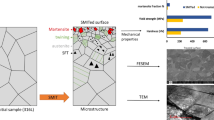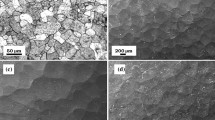Abstract
In surface mechanical attrition treatment (SMAT), the processing parameters like the diameter of hardened steel balls/shots (D) and their impact velocity (V) are crucial in affecting the mechanical properties of the materials. This study is focused on understanding the effect of D and V on microstructural and hardness variation during the SMAT process. The SMAT has been performed on AISI 304L steel using 3-mm and 8-mm diameter balls with a combination of 1 m/s and 10 m/s impact velocity. Microstructure of the SMATed material shows twin distribution near the top surface changeover from coarser to finer when V increases from a low to significantly high value, whereas it changes marginally with an increase in D. Nanoindentation experiments performed along the depth of SMATed material reveal that the near-surface hardness is mainly governed by V and weakly influenced by D. However, the hardened layer thickness is enhanced by increasing either of these parameters. The complementary finite element (FE) simulations of the single impact SMAT process are performed using the rate-dependent Johnson–Cook plasticity model to provide the mechanistic reasons for the behavior observed from the experiments. A strategy to determine the hardness-depth profile of SMATed steel through FE simulations is developed. The hardness behavior of the SMATed steel is linked to the effects of D and V on the residual equivalent stress and equivalent plastic strain at the surface. The hardness away from the surface is influenced by the shot size and shot velocity. The empirical relations that show the dependence of hardness on the SMAT parameters are determined.
















Similar content being viewed by others
Data availability
The datasets generated during and/or analyzed during the current study are available from the corresponding author on reasonable request.
References
Kheiri S, Mirzadeh H, Naghizadeh M (2019) Tailoring the microstructure and mechanical properties of AISI 316L austenitic stainless steel via cold rolling and reversion annealing. Mater Sci Eng, A 759:90–96. https://doi.org/10.1016/j.msea.2019.05.028
San Marchi C, Ronevich JA, Sabisch JEC, Sugar JD, Medlin DL, Somerday B (2020) Effect of microstructural and environmental variables on ductility of austenitic stainless steels. Int J Hydrogen Energy 46(23):12338–12347. https://doi.org/10.1016/j.ijhydene.2020.09.069
Capeletti T, Louthan M Jr (1977) The tensile ductility of austenitic steels in air and hydrogen. J Eng Mater Technol 99(2):153–158. https://doi.org/10.1115/1.3443426
Hosseinalipour S, Ershad-Langroudi A, Hayati AN, Nabizade-Haghighi A (2010) Characterization of sol–gel coated 316L stainless steel for biomedical applications. Prog Org Coat 67(4):371–374. https://doi.org/10.1016/j.porgcoat.2010.01.002
Rho BS, Hong HU, Nam SW (2000) The effect of δ-ferrite on fatigue cracks in 304L steels. Int J Fatigue 22(8):683–690. https://doi.org/10.1016/S0142-1123(00)00043-8
Soyama H (2020) Comparison between shot peening, cavitation peening, and laser peening by observation of crack initiation and crack growth in stainless steel. Metals 10(1):63. https://doi.org/10.3390/met10010063
Tian J, Villegas J, Yuan W, Fielden D, Shaw L, Liaw P, Klarstrom D (2007) A study of the effect of nanostructured surface layers on the fatigue behaviors of a C-2000 superalloy. Mater Sci Eng, A 468:164–170. https://doi.org/10.1016/j.msea.2006.10.150
Wang C, Wang C, Wang L, Lai Y, Li K, Zhou Y (2020) A dislocation density–based comparative study of grain refinement, residual stresses, and surface roughness induced by shot peening and surface mechanical attrition treatment. The International Journal of Advanced Manufacturing Technology 108:505–525. https://doi.org/10.1007/s00170-020-05413-8
Ke L, Jian L (1999) Surface nanocrystallization (SNC) of metallic materials-presentation of the concept behind a new approach. J Mater Sci Technol 15(3):193–197. https://www.scopus.com/record/display.uri?eid=2-s2.0-0000506802&origin=recordpage. Accessed date March 3, 2021
Gatey A, Hosmani S, Singh R (2016) Surface mechanical attrition treated AISI 304L steel: role of process parameters. Surf Eng 32(1):69–78. https://doi.org/10.1179/1743294415Y.0000000056
Zhu L, Guan Y, Wang Y, Xie Z, Lin J (2017) Influence of process parameters of ultrasonic shot peening on surface nanocrystallization and hardness of pure titanium. Int J Adv Manuf Technol 89(5–8):1451–1468. https://doi.org/10.1007/s00170-016-9181-4
Lin Y, Cai Z-B, Li Z-Y, Yin M-G, Wang W-J, He W-F, Zhou Z-R (2019) Study on the abrasive wear behavior of laser shock peening Ti-6Al-4V titanium alloy under controlled cycling impact. Wear 426:112–121. https://doi.org/10.1016/j.wear.2019.01.112
Goli F, Jamaati R (2019) Effect of strain path during cold rolling on the microstructure, texture, and mechanical properties of AA2024 aluminum alloy. Materials Research Express 6(6):066514. https://doi.org/10.1088/2053-1591/ab0a1f
Astaraee AH, Miresmaeili R, Bagherifard S, Guagliano M, Aliofkhazraei M (2017) Incorporating the principles of shot peening for a better understanding of surface mechanical attrition treatment (SMAT) by simulations and experiments. Mater Des 116:365–373. https://doi.org/10.1016/j.matdes.2016.12.045
Wen M, Wen C, Hodgson P, Li Y (2012) Thermal oxidation behaviour of bulk titanium with nanocrystalline surface layer. Corros Sci 59:352–359. https://doi.org/10.1016/j.corsci.2012.03.005
Wang L, Wang Z, Lu K (2011) Grain size effects on the austenitization process in a nanostructured ferritic steel. Acta Mater 59(9):3710–3719. https://doi.org/10.1016/j.actamat.2011.03.006
Frontán J, Zhang Y, Dao M, Lu J, Gálvez F, Jérusalem A (2012) Ballistic performance of nanocrystalline and nanotwinned ultrafine crystal steel. Acta Mater 60(3):1353–1367. https://doi.org/10.1016/j.actamat.2011.11.029
Bahl S, Shreyas P, Trishul M, Suwas S, Chatterjee K (2015) Enhancing the mechanical and biological performance of a metallic biomaterial for orthopedic applications through changes in the surface oxide layer by nanocrystalline surface modification. Nanoscale 7(17):7704–7716. https://doi.org/10.1039/C5NR00574D
Olugbade TO, Lu J (2020) Literature review on the mechanical properties of materials after surface mechanical attrition treatment (SMAT). Nano Materials Science 2(1):3–31. https://doi.org/10.1016/j.nanoms.2020.04.002
Dureau C, Novelli M, Arzaghi M, Massion R, Bocher P, Nadot Y, Grosdidier T (2020) On the influence of ultrasonic surface mechanical attrition treatment (SMAT) on the fatigue behavior of the 304L austenitic stainless steel. Metals 10(1):100. https://doi.org/10.3390/met10010100
Chan H, Ruan H, Chen A, Lu J (2010) Optimization of the strain rate to achieve exceptional mechanical properties of 304 stainless steel using high speed ultrasonic surface mechanical attrition treatment. Acta Mater 58(15):5086–5096. https://doi.org/10.1016/j.actamat.2010.05.044
Tao N, Wang Z, Tong W, Sui M, Lu J, Lu K (2002) An investigation of surface nanocrystallization mechanism in Fe induced by surface mechanical attrition treatment. Acta Mater 50(18):4603–4616. https://doi.org/10.1016/S1359-6454(02)00310-5
Zhang X, Lu J, Shi S (2011)A computational study of plastic deformation in AISI 304 induced by surface mechanical attrition treatment. Mech Adv Mater Struct 18(8):572–577. https://doi.org/10.1080/15376494.2011.621828.
Tao N, Zhang H, Lu J, Lu K (2003) Development of nanostructures in metallic materials with low stacking fault energies during surface mechanical attrition treatment (SMAT). Mater Trans 44(10):1919–1925. https://doi.org/10.2320/matertrans.44.1919
Arifvianto B, Mahardika M, Dewo P, Iswanto P, Salim U (2011) Effect of surface mechanical attrition treatment (SMAT) on microhardness, surface roughness and wettability of AISI 316L. Mater Chem Phys 125(3):418–426. https://doi.org/10.1016/j.matchemphys.2010.10.038
Samih Y, Beausir B, Bolle B, Grosdidier T (2013) In-depth quantitative analysis of the microstructures produced by Surface Mechanical Attrition Treatment (SMAT). Mater Charact 83:129–138. https://doi.org/10.1016/j.matchar.2013.06.006
Novelli M, Bocher P, Grosdidier T (2018) Effect of cryogenic temperatures and processing parameters on gradient-structure of a stainless steel treated by ultrasonic surface mechanical attrition treatment. Mater Charact 139:197–207. https://doi.org/10.1016/j.matchar.2018.02.028
Edberg J, Lindgren LE, Ken-Ichiro M (1995) Shot peening simulated by two different finite element formulations. International Conference on Numerical Methods in Industrial Forming Processes: Balkema Publishers, AA/Taylor & Francis The Netherlands, 18/06/1995–21/06/1995
Guagliano M (2001) Relating Almen intensity to residual stresses induced by shot peening: a numerical approach. J Mater Process Technol 110(3):277–286. https://doi.org/10.1016/S0924-0136(00)00893-1
Chen Z, Sun Z, Panicaud B (2018) Constitutive modeling of TWIP/TRIP steels and numerical simulation of single impact during Surface Mechanical Attrition Treatment. Mech Mater 122:69–75. https://doi.org/10.1016/j.mechmat.2018.04.005
Herrera C, Ponge D, Raabe D (2011) Design of a novel Mn-based 1 GPa duplex stainless TRIP steel with 60% ductility by a reduction of austenite stability. Acta Mater 59(11):4653–4664. https://doi.org/10.1016/j.actamat.2011.04.011
Mahato B, Sahu T, Shee S, Sahu P, Sawaguchi T, Kömi J, Karjalainen L (2017) Simultaneous twinning nucleation mechanisms in an Fe–Mn–Si–Al twinning induced plasticity steel. Acta Mater 132:264–275. https://doi.org/10.1016/j.actamat.2017.04.046
Abreu HF, Carvalho SS, Lima Neto PD, Santos RP, Freire VN, Silva PM, Tavares SS (2007) Deformation induced martensite in an AISI 301LN stainless steel: characterization and influence on pitting corrosion resistance. Mater Res 10(4):359–366. https://doi.org/10.1590/S1516-14392007000400007
Tiamiyu A, Szpunar J, Odeshi A (2019) Strain rate sensitivity and activation volume of AISI 321 stainless steel under dynamic impact loading: grain size effect. Mater Charact 154:7–19. https://doi.org/10.1016/j.matchar.2019.05.027
Miao HY, Larose S, Perron C, Lévesque M (2009) On the potential applications of a 3D random finite element model for the simulation of shot peening. Adv Eng Softw 40(10):1023–1038. https://doi.org/10.1016/j.advengsoft.2009.03.013
Johnson GR, Cook WH (1985) Fracture characteristics of three metals subjected to various strains, strain rates, temperatures and pressures. Eng Fract Mech 21(1):31–48. https://doi.org/10.1016/0013-7944(85)90052-9
Wu G, Wang Z, Gan J, Yang Y, Meng Q, Wei S, Huang H (2019) FE analysis of shot-peening-induced residual stresses of AISI 304 stainless steel by considering mesh density and friction coefficient. Surf Eng 35(3):242–254. https://doi.org/10.1080/02670844.2018.1470817
Cai S, Liu J, Zhang P, Li C, Cheng Y (2020) Dynamic response of sandwich panels with multi-layered aluminum foam/UHMWPE laminate cores under air blast loading. Int J Impact Eng 138:103475. https://doi.org/10.1016/j.ijimpeng.2019.103475
Maurel-Pantel A, Fontaine M, Thibaud S, Gelin J-C (2012) 3D FEM simulations of shoulder milling operations on a 304L stainless steel. Simul Model Pract Theory 22:13–27. https://doi.org/10.1016/j.simpat.2011.10.009
Tasdemirci A, Sahin S, Kara A, Turan K (2015) Crushing and energy absorption characteristics of combined geometry shells at quasi-static and dynamic strain rates: experimental and numerical study. Thin-Walled Structures 86:83–93. https://doi.org/10.1016/j.tws.2014.09.020
Singh D, Basha DA, Singh A, Devan RS, Hosmani SS (2020) Microstructural and passivation response of severely deformed AISI 304 steel surface: the role of surface mechanical attrition treatment. J Mater Eng Perform 29(10):6898–6911. https://doi.org/10.1007/s11665-020-05161-6
Iida K (2000) Dent and affected layer produced by shot peening. The Shot Peener 14(3):4-7
Ghelichi R, Crispiatico G, Guagliano M, Bagherifard S (2018) An energetic approach to predict the effect of shot peening-based surface treatments. Metals 8(3):190. https://doi.org/10.3390/met8030190
Zhou F, Jiang W, Du Y, Xiao C (2019) A comprehensive numerical approach for analyzing the residual stresses in AISI 301LN stainless steel induced by shot peening. Materials 12(20):3338. https://doi.org/10.3390/ma12203338
Meguid S, Shagal G, Stranart J (2002) 3D FE analysis of peening of strain-rate sensitive materials using multiple impingement model. Int J Impact Eng 27(2):119–134. https://doi.org/10.1016/S0734-743X(01)00043-4
Jianming W, Feihong L, Feng Y, Gang Z (2011) Shot peening simulation based on SPH method. Int J Adv Manuf Technol 56(5–8):571–578. https://doi.org/10.1007/s00170-011-3193-x
Hirmukhe S, Prasad KE, Singh I (2020) Investigation of pressure sensitive plastic flow in nanoglasses from finite element simulations. Scripta Mater 180:45–50. https://doi.org/10.1016/j.scriptamat.2020.01.022
Lichinchi M, Lenardi C, Haupt J, Vitali R (1998) Simulation of Berkovich nanoindentation experiments on thin films using finite element method. Thin Solid Films 312(1–2):240–248. https://doi.org/10.1016/S0040-6090(97)00739-6
Acknowledgements
The Nanoindentor Facility at the Dept. of Metallurgical Engineering and Materials Science, IIT Bombay, is kindly acknowledged.
Funding
This research was supported by the Science and Engineering Research Board under Grant No. EMR/2017/001196.
Author information
Authors and Affiliations
Contributions
Vikesh Kumar: conceptualization, experimentation, simulation and analysis, and writing-original draft. Anurag Sharma: simulation and analysis. Santosh Sattappa Hosmani: conceptualization, experimentation, project administration, supervision, reviewing, and editing. Indrasen Singh: conceptualization, simulation and analysis, project administration, supervision, reviewing, and editing.
Corresponding author
Ethics declarations
Ethics approval
This research does not involve human participants and/or animals.
Consent to participate
All authors have read and approved the final manuscript.
Consent for publication
All authors have read and agreed to publish the final version of the manuscript.
Competing interests
The authors declare no competing interests.
Additional information
Publisher's Note
Springer Nature remains neutral with regard to jurisdictional claims in published maps and institutional affiliations.
Rights and permissions
About this article
Cite this article
Kumar, V., Sharma, A., Hosmani, S.S. et al. Effect of ball size and impact velocity on the microstructure and hardness of surface mechanical attrition–treated 304L steel: experiment and finite element simulations. Int J Adv Manuf Technol 120, 3251–3267 (2022). https://doi.org/10.1007/s00170-022-08978-8
Received:
Accepted:
Published:
Issue Date:
DOI: https://doi.org/10.1007/s00170-022-08978-8




